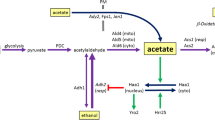Abstract
The glucose-utilizing mutantHydrogenomonas strain H16G+ differs from the original strain H16 in having a higher specific activity of glucose-6-phosphate dehydrogenase. During incubation of the original strain or of the mutant H16G+ in a mineral salts/fructose-medium under an atmosphere of 80% H2 + 20% O2, neither growth nor formation of the enzymes of the Entner-Doudoroff system occur. Molecular hydrogen represses the formation of these enzymes even in the presence of carbon dioxide, peptone, or lactate. Under air, the formation of the enzymes of the Entner-Doudoroff pathway is not repressed by lactate nor by acetate, glutamate or pyruvate. In strain H16G+ fructose suppresses the adaptation to glucose; glucose does not repress the formation of a fructose permease. Fructose also suppresses adaptation to and utilization of glutamate and aspartate, but not of lactate. In cells grown either chemolithotrophically or on fructose acetyl-CoA kinase, malate synthase and isocitrate lyase are rapidly formed under air after addition of acetate; the formation of these enzymes is also completely suppressed by molecular hydrogen or fructose.
Similar content being viewed by others
References
Beisenherz, G., Boltze, H. J., Bücher, Th., Czok, R., Garbade, K. H., Meyer-Arendt, E. undPfeleiderer, G. 1953. Diphosphofructose-Aldolase, phosphoglycerinaldehyd-Dehydrogenase, Milchsäuredehydrogenase, Glycerophosphat-Dehydrogenase und Pyruvat-Kinase aus Kaninchenmuskel in einem Arbeitsgang. Z. Naturforsch.8b 555–577.
Berg, P. 1956. Acyl adenylates: an enzymatic mechanism of acetate activation. J. Biol. Chem.222 991–1013.
Bergmeyer, H. U. undBernt, E. 1962.d-Glucose. Bestimmung mit Glucose-Oxydase und Peroxydase, S. 123–130.In H. U. Bergmeyer, Methoden der enzymatischen Analyse. Verlag Chemie, Weinheim.
Decker, K. 1959. Die aktivierte Essigsäure. F. Enke Verlag, Stuttgart.
Dixon, G. H. andKornberg, H. L. 1959. Assay methods for key enzymes of the glyoxylate cycle. Biochem. J.72: 3P.
Eisenberg, M. A. 1955. The acetate-activating enzyme ofRhodospirillum rubrum. Biochim. Biophys. Acta16 58–65.
French, C. S. andMilner, H. W. 1955. Disintegration of bacteria and small particles by high pressure extrusion, p. 64–67.In S. P. Colowick and N. O. Kaplan: Methods in enzymology, Vol. I. Academic Press, New York.
Gale, E. F. 1943. Factors influencing the enzymic activities of bacteria. Bacteriol. Rev.7 139–173.
Gottschalk, G. 1965. Die Verwertung organischer Substrate durchHydrogenomonas in Gegenwart von molekularem Wasserstoff. Biochem. Z.341 260–270.
Gottschalk, G., Eberhardt, U. undSchlegel, H. G. 1964. Verwertung von Fructose durchHydrogenomonas H 16 (I.). Arch. Mikrobiol.48 95–108.
Hohorst, H.-J. 1962.l-(+)-Lactat, S. 266–270.In H. U. Bergmeyer, Methoden der enzymatischen Analyse. Verlag Chemie, Weinheim.
Hughes, D. E. 1951. A press for disrupting bacteria and other micro-organisms. Brit. J. Exptl. Pathol.32 97–109.
Jacob, F. andMonod, J. 1961. Genetic regulatory mechanism in the synthesis of proteins. J. Mol. Biol.3 318–356.
Jones, M. E. andLipmann, F. 1955. Aceto-CoA-kinase, p. 585–591.In S. P. Colowick and N. O. Kaplan, Methods in Enzymology, Vol. I. Academic Press, New York.
Kornberg, H. L. andElsden, S. R. 1961. The metabolism of 2-carbon compounds by microorganisms. Advan. Enzymol.23 401–470.
Loomis, W. F., Jr. andMagasanik, B. 1964. The relation of catabolite repression to the induction system forβ-galactosidase inEscherichia coli. J. Mol. Biol.8 417–426.
McFadden, B. A. andHowes, W. V. 1962. Isocitrate lyase and malate synthase inHydrogenomonas facilis. J. Biol. Chem.237 1410–1412.
Magasanik, B. 1961. Catabolite repression. Cold Spring Harbor Symp. Quant. Biol.26 249–256.
Magasanik, B. 1964. Enzyme induction and catabolite repression. 6th Intern. Congr. Biochem. Abstr.9 680–681.
Nakada, D. andMagasanik, B. 1964. The roles of inducer and catabolite repressor in the synthesis ofβ-galactosidase byEscherichia coli. J. Mol. Biol.8 105–127.
Ohmann, E. 1963. Verschiedene Mechanismen der Acetataktivierung in Grünalgen. Naturwiss.50 578.
la Rivière, J. W. M. 1958. On the microbial metabolism of the tartaric acid isomers. Thesis, Delft.
Rose, I. A. 1955. Acetate kinase of bacteria (acetokinase), p. 591–595.In S. P. Colowick and N. O. Kaplan, Methods in enzymology, Vol. I. Academic Press, New York.
Schindler, J. 1964. Die Synthese von Poly-β-hydroxybuttersäure durchHydrogenomonas H 16: Die zuβ-Hydroxybutyryl-Coenzym A führenden Reaktionsschritte. Arch. Mikrobiol.49 236–255.
Schlegel, H. G. undGottschalk, G. 1965. Verwertung von Glucose durch eine Mutante von Hydrogenomonas H16. Biochem. Z.341 249–259.
Schlegel, H. G., Gottschalk, G. andvon Bartha, R. 1961. Formation and utilization of poly-β-hydroxybutyric acid by knallgas bacteria (Hydrogenomonas). Nature191 463–465.
Schlegel, H. G., Kaltwasser, H. undGottschalk, G. 1961. Ein Submersverfahren zur Kultur wasserstoffoxydierender Bakterien: Wachstumsphysiologische Untersuchungen. Arch. Mikrobiol.38 209–222.
Schmidt, K., Liaaen Jensen, S. undSchlegel, H. G. 1963. Die Carotinoide der Thiorhodaceae. I. Okenon als Hauptcarotinoid vonChromatium okenii Perty. Arch. Mikrobiol.46 117–126.
Simon, E. J. andShemin, D. 1953. The preparation of S-succinyl coenzyme A. J. Amer. Chem. Soc.75 2520.
Spier, H. W. undPascher, G. 1954. Zur quantitativen Mikro-analyse freier Aminosäuren mittels einer einfachen Cu-Komplexmethode. Z. Physiol. Chemie296 147–154.
Stadtman, T. C. 1955. Cholesterol dehydrogenase from aMycobacterium, p. 678–681.In S. P. Colowick and N. O. Kaplan, Methods in enzymology, Vol. I. Academic Press, New York.
Trüper, H. G. 1965. Tricarboxylic acid cycle and related enzymes inHydrogenomonas strain H16G+ grown on various carbon sources. Biochim. Biophys. Acta.111 565–568.
Wilde, E. 1962. Untersuchungen über Wachstum und Speicherstoffsynthese vonHydrogenomonas. Arch. Mikrobiol.43 109–137.
Author information
Authors and Affiliations
Rights and permissions
About this article
Cite this article
Schlegel, H.G., Trüper, H.G. Repression of enzyme formation inHydrogenomonas strain H16G+ by molecular hydrogen and by fructose. Antonie van Leeuwenhoek 32, 277–292 (1966). https://doi.org/10.1007/BF02097470
Received:
Issue Date:
DOI: https://doi.org/10.1007/BF02097470




